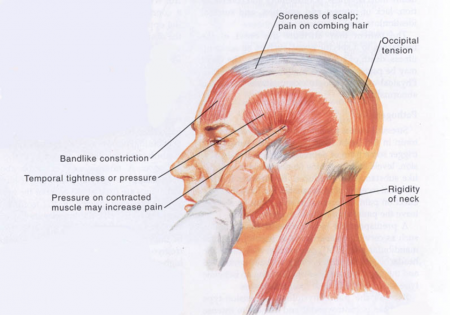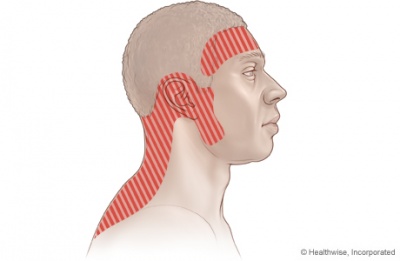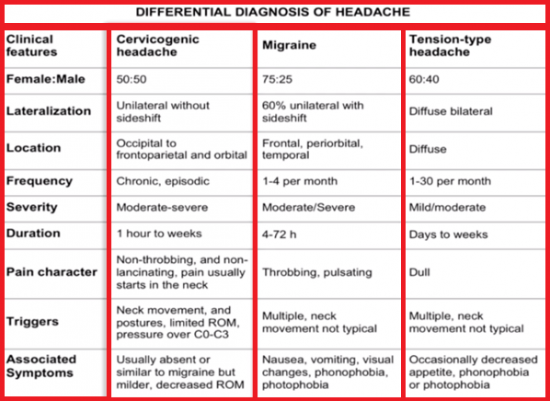Definition/Description
Tension-type headache (TTH) imposes a heavy burden on the global population but remains incompletely understood and poorly managed. This is the most common type of primary headache: its lifetime prevalence in the general population ranges in different studies from 30 to 78%. At the same time, it is the least studied of the primary headache disorders, despite the fact that it has the highest socio-economic impact.
Tension-type headache is a neurological disorder characterized by a predisposition of attacks from mild to moderate headache with few associated symptoms that you can find in the subtitle ‘Characteristics’ (2).
The criteria for tension-type headache are based on the IHS classification. They are mentioned in the subtitle ‘Diagnostic Procedures’.
The exact mechanisms of tension-type headache are not known. Peripheral pain mechanisms are most likely to play a role in Infrequent episodic tension-type headache and frequent episodic tension-type headache, whereas central pain mechanisms play a more important role in Chronic tension-type headache. (1)(2)
Tension-type headaches are divided into:
Infrequent episodic
The infrequent subtype has episodes less than once per month and has very little impact on the individual. The pain is typically bilateral, pressing, or tightening in quality and mild to moderate intensity. It is not worsened with physical activity. There is no nausea, but photophobia or phonophobia may be present.(3)(4)
Frequent episodic
Frequent sufferers (between one and fifteen days a month) can encounter considerable disability that sometimes needs expensive drugs and prophylactic medication. This frequent form is a physiologic response to stress, anxiety, depression, emotional conflicts, fatigue or repressed hostility.(3)(4)
Chronic tension-type headaches
The chronic subtype evolves over time from episodic tension-type headache. It is a serious disease, causes greatly decreased quality of life and high disability. It is diagnosed if headaches occur 15 days a month (180 or more days a year). (3)(4)
Probable tension-type headache
Some tension type headaches could be classified only as probable tension-type headache.
Clinically Relevant Anatomy
The brain itself is insensitive to pain, so that is not what hurts when a headache arises.
The pain, instead, occurs in the following locations:
– The tissues covering the brain.
– The attaching structures at the base of the brain.
– Muscles and blood vessels around the scalp, face, and neck.
The pain is commonly described as a tight feeling, as if the head were in a vise. It usually occurs on both sides of the head and is often experienced in the forehead, in the back of the head and neck, or in both regions. Soreness in the shoulders or neck is common. The muscles who are tight in the frontal and temporal regio are: the masseter, pterygoid, sternocleidomastoid, splenius and trapezius muscles.
Most of all the pain the patient feels is in the following area:
– The pain is of mild-to-moderate intensity and is steady, not throbbing or pulsating.
– The headache is not accompanied by nausea or vomiting.
– The pain is not worsened by routine physical activity (climbing stairs, walking).
– Some patients may have either sensitivity to light or sensitivity to noise, but not both.
Epidemiology /Etiology
The causes of tension-type headache are still uncertain. Although tension-type headaches were once thought to be primarily due to muscle contractions, this theory has largely been discounted. Instead, researchers think that tension-type headaches occur due to an interaction of different factors that involve pain sensitivity and perception, as well as the role of brain chemicals (neurotransmitters). Genetic factors are likely be involved in chronic tension-type headache, whereas environmental factors (physical and psychological stress) may play a role in the physiologic processes involved with episodic tension-type headache.
Pain Sensitivity and perception
Research indicates that patients with tension-type headache may have abnormalities in the central nervous system, which includes the nerves in the brain and spine, that increase their sensitivity to pain.
Brain Chemicals (neurotransmitters) Infrequent episodes of headache lasting minutes to days. The pain is typically bilateral, pressing or tightening in quality and of mild to moderate intensity, and it does not worsen with routine physical activity. There is no nausea but photophobia or phonophobia may be present. Frequent episodes of headache lasting minutes to days. The pain is typically bilateral, pressing or tightening in quality and of mild to moderate intensity, and it does not worsen with routine physical activity. There is no nausea but photophobia or phonophobia may be present. A disorder evolving from episodic tension-type headache, with daily or very frequent episodes of headache lasting minutes to days. The pain is typically bilateral, pressing or tightening in quality and of mild to moderate intensity, and it does not worsen with routine physical activity. There may be mild nausea, photophobia or phonophobia. The prognosis for tension-type headache in the general population is favourable: 45% of adults with frequent or chronic tension-type headache at baseline were in remission when examined three years later, although 39% still had frequent headaches, and 16% had chronic tension-type headache. Poor outcome was associated with the presence of chronic tension-type headache at baseline, coexisting migraine, not being married, and sleep problems. Predictive factors for remission were older age and absence of chronic tension-type headache at baseline. The prognosis for patients who need medical intervention or specialist headache care is presumably not so favourable but is difficult to determine because case mix varies considerably from clinic to clinic and country to country. (2)(5) Migraines and tension headaches have some similar characteristics, but also some important differences(24): – Medication-overuse headache: History of previous primary headache. Use of analgesics and ergotamine at a high frequency and worsening of headache on discontinuation of medication. Over several months, frequency and duration increases such that attacks become daily or near daily, although not necessarily more severe. Opioids and barbiturate-containing analgesics most commonly produce this syndrome.
– Sphenoid sinusitis: Vertex or frontal pain, often described as pressure, but not necessarily with additional sinus symptoms. Diagnostic criteria for the 3 subtypes of tension-type headache from the IHS classification
1. At least 10 episodes occurring on 2. Headache lasting from 30 minutes to 7 days 1. At least 10 episodes occurring on ≥1 but 2. Headache lasting from 30 minutes to 7 days 1. Headache occurring on ≥15 days per month on average for >3 months (≥180 days per year)1 and fulfilling criteria 2-4 1) HARDSHIP: The Headache-Attributed Restriction, Disability, Social Handicap and Impaired Participation questionnaire which is designed for application by medical or trained interviewers. HARDSHIP integrates diagnostic questions (these are based on ICHD-3 β criteria), demographic enquiry and investigate the several components of headache-attributed burden: symptom burden, health-care utilization, disability and productive time loss, the impact on education and earnings, perception of control, interictal burden, overall individual burden, effects on relationships and family, effects on other people including household partner and children, quality of life, wellbeing, obesity as a comorbidity. 84
2) Quality of life: WHOQoL-BREF (World Health Organization Quality of Life Questionnaire-BREF). This is an shortened version of the WHOQoL-100 developed by The World Health Organization. It’s a self-report questionnaire that contains 26 items, these are subdivided into 4 QoL domains: psychological health, physical health, social relationships, environment and two other items which measure general health and overall QoL. 9 3) The Headache Impact Test-6 questionnaire (HIT-6): this questionnaire evaluates the impact of headache on the quality of life.10 After appropriately diagnosing TTHs, medical professionals must then determine what the most effective treatment is for these headaches. Due to the lack of knowledge of concerning the etiology of TTHs, they are very difficult to treat. Medical professionals try to incorporate patient education, lifestyle modifications, and cost-effective medications into their treatments.11 An example of a lifestyle modification would be discussing smoking cessation with one’s patient. There is a strong positive correlation between how many cigarettes are smoked and how many days out of the week patients experience headaches. Research has also found a positive correlation between high volumes of nicotine and higher anger, anxiety, and depression. Although drug therapy is finite in its ability to treat the underlying cause of TTHs, it has still been found to be effective in relieving symptoms of pain many patients.
A simple randomized controlled trail by D’Souza et al proved that relaxation therapy was effective to improve the headache frequency en also led to an immediate increase of calmness. But it was only a brief protocol with 3 months follow up so further investigation is necessary. [13] The review written by Wallash et al, confirms that there is a benefit for patients with TTH to participate in relaxation therapy, 1 hour a day, if they have severefrequent episodic chronicitheadachey(10days/month). [14] Quinn et al. found that muscle-specific massage therapy was a non-pharmacological intervention effective for reducing tension type headache. [15
To use acupuncture as pain relief in TTH, Linde K. et al reviewed 11 trails. The authors concluded that acupuncture could be a valuable non-pharmacological tool in patients with frequent episodes or chronic tension-type headaches.[16]
The use of spinal manipulations is quite controversial, especially when performed in the neck because of the reported adverse reaction and patients’ concerns about safety. The adverse reaction range from minor conditions such as stiffness and limitation in motion to more severe kind like permanent neurological deficits or dissection of vertebral arteries. A recent study of Castien et al reported that manual therapy is more effective than usual general practice care in reducing symptoms of chronic tension type headache. This practice care includes posture corrections and maintaining these. These corrections mostly apply in the frontal plane.[17]
A literature review of Victoria et aL shows us that physiotherapy with articulatory manual therapy, combined with cervical muscle stretching and massage are effective for this disease in different aspects related with TTH. No evidence was found of the effectiveness of the techniques applied separately. [18]
Other studies demonstrate the fact that spinal manipulations were effective for tension type headache included patients with the chronic condition. Therefore, spinal joint manipulation may be more effective in chronic than in episodic tension type headache. Fernandez-de-las-Penas et al suggest that when a patient with headache is mediated primarily by peripheral mechanisms (dominantly peripheral sensitization), early and appropriate local treatments and functional activity should be encouraged. In the appropriate local treatment ae massages and stretching techniques included. In a patient with frequent episodic tension type headache, a manual therapy approach including inactivation of active trigger points in the upper trapezius, sternocleidomastoid, temporalis, suboccipital, extra-ocular superior oblique or extraocular lateral rectus muscles, cervical mobilization/manipulation, and exercises targeted to the neck flexor or extensor synergy cooperation may be appropriate. Example of deep cervical flexor exercise: The patient is asked to gently nod the head as he/she was saying ‘yes’ without restoring to retraction, without strictly involvement of superficial flexors, and without a quick, jerky cervical flexion movement [19]
Despite all the positive findings, evidence-based guidelines recommend the application of spinal manipulations for migraine and cervicogenic headache, but not for tension type headache.
These inconsistency results in non-appropriate treatment of patients. http://www.moveforwardpt.com/symptomsconditionsdetail.aspx?cid=fd8a18c8-1893-4dd3-9f00-b6e49cad5005
www.who.int/mediacentre/factsheets/fs277/en/
umm.edu/health/medical/altmed/condition/tension-headache
Neurotransmitters are chemical messengers in the brain. Several types of neurotransmitters have been identified as playing a role in increasing activity in pain pathways in the brain and affecting how the brain reacts to pain stimulation. In particular, serotonin (also called 5-HT) and nitric oxide are thought to be involved in these chemical changes. Release of these chemicals may activate nerve pathways in the brain, muscles, or elsewhere and increase pain.
5.1 Infrequent episodic tension-type headache
5.2 Frequent episodic tension-type headache
Frequent tension-type headache often coexists with migraine without aura. Coexisting tension-type headache in migraineurs should preferably be identified by a diagnostic headache diary. The treatment of migraine differs considerably from that of tension-type headache and it is important to educate patients to differentiate between these types of headaches in order to select the right treatment and to prevent medication-overuse headache.5.3 Chronic tension-type headache
Differentiation between this and Chronic migraine can be difficult. It should be remembered that some patients with chronic tension-type headache develop migraine-like features if they have severe pain and, conversely, some migraine patients develop increasingly frequent tension-type-like interval headaches, the nature of which remains unclear. (3)5.4 Prognosis
Differential diagnosis TTH and migraine:
– Migraine pain is usually throbbing, while tension-type headache pain is usually a steady ache
– Migraine pain often affects only one side of the head, while tension-type headache pain typically affects both sides of the head
– Migraine headaches, but not tension-type headaches, may be accompanied by nausea or vomiting, sensitivity to light and sound, or aura
Some other differential diagnosis :
– Giant cell arteritis: Generally over 50 years of age. New head pain associated with soreness of the scalp; polymyalgia rheumatica and often jaw or tongue claudication.
– Temporomandibular disorder (TMD): Pain over temporalis associated with noise and clicking over TMJ with jaw movement. Often associated with bruxism and limited jaw movements, or pain or locking of the jaw with opening of mouth.
– Pituitary tumor: Abnormal neurologic examination. Visual field defects and galactorrhea may occur.
– Brain tumor: Abnormal neurologic examination including reflex asymmetry, sensory asymmetry, or motor weakness. Papilledema suggests an intracranial mass lesion.
– Chronic subdural hematoma: Abnormal mentation, abnormal neurologic examination including reflex asymmetry, sensory asymmetry, or motor weakness.
– Pseudotumor cerebri (idiopathic intracranial hypertension): As well as papilledema, there may be reduced visual acuity, visual field defect (enlarged blind spot), or diplopia caused by a sixth nerve palsy. CSF pressures are abnormal and are increased to >200 mm water in nonobese and >250 mm water in obese people.
– Cervical pathology: Rarely, serious cervical pathology such as a herniated disk may contribute to headache. (3)Diagnostic criteria for Infrequent episodic tension-type headache:
3. Headache has at least two of the following characteristics:
-bilateral location
-pressing/tightening (non-pulsating) quality
-mild or moderate intensity
-not aggravated by routine physical activity such as walking or climbing stairs
4. Both of the following:
-no nausea or vomiting (anorexia may occur)
-no more than one of photophobia or phonophobia
5. Not better accounted for by another ICHD-3 diagnosis.
Diagnostic criteria for Frequent episodic tension-type headache:
3. Headache has at least two of the following characteristics:
-bilateral location
-pressing/tightening (non-pulsating) quality
-mild or moderate intensity
-not aggravated by routine physical activity such as walking or climbing stairs
4. Both of the following:
-no nausea or vomiting (anorexia may occur)
-no more than one of photophobia or phonophobia
5. Not better accounted for by another ICHD-3 diagnosis.
Diagnostic criteria for Chronic tension-type headache:
2. Headache lasts hours or may be continuous
3. Headache has at least two of the following characteristics:
-bilateral location
-pressing/tightening (non-pulsating) quality
-mild or moderate intensity
-not aggravated by routine physical activity such as walking or climbing stairs
4. Both of the following:
-no more than one of photophobia, phonophobia or mild nausea
-neither moderate or severe nausea nor vomiting
5. Not better accounted for by another ICHD-3 diagnosis



